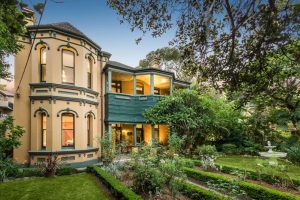
Annie Sophine Kerr (1866–1934) , born Carlson, lived at 270 Glebe Point Road for 20 years before the property was sold to the NSW Government in 1924. Known locally today as Trickett’s after a recent owner, the house was numbered 204 and 234 before the address was fixed in 1906. The land was a double block stretching from the main road to Edward Street at the rear.
First occupiers
The land was built on in 1846 by druggist Charles Marcian Penny and formed part of John Pendrill’s Collegiate School which moved in 1878 to the site on which Glebe Library now stands. The house was then occupied by Frederick Jackson MA until his suicide in 1883, and then by John Fletcher, another teacher. In September 1887 it and its twin neighbour Eglinton were sold by the Penny family to Stephen Josiah Bryen, a wealthy landowner who had been educated at the Collegiate School. Four years later, Bryen demolished the house on what is today’s No. 270 and sold the land to William Robert Pope for £1,350. Trading as John Pope and Company, William was a fruit importer and exporter with a storehouse in York Street in the city.
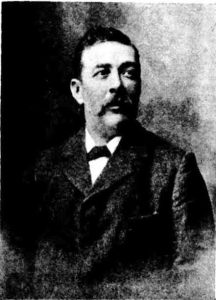
Pope built a new house which he christened Rewa Villa and which he said cost him £4,000. The choice of name was perhaps after the area in Fiji where there were significant sugar cane, banana and pineapple plantations at that time. The slate-roofed mansion contained five bedrooms and multiple public rooms; in the grounds were a fowl house, large stables and a double coachhouse. Pope lived in Rewa until he was hit by the 1890s economic depression. After an unsuccessful attempt to sell the property in late 1893, he rented it out. George McCredie, architect, moved in with his family but left after his son James died there one night while he himself was chairman of a jury locked up during the trial of wife poisoner George Dean.
The house, renamed Wahroonga, was advertised for rent in June 1896. The new tenant was William Thomas Ashton Shorter, a solicitor in partnership with Reginald Edgar Ashton Shorter, the oldest of his nine children. William and his wife Margaret, born Chippendale lived there for a couple of years with junior members of the family before moving to Rhodesia at 28 Toxteth Road where Margaret died in 1900. Her widower married Heloise Blanche Mayne in 1901, was declared bankrupt in 1912 and died at Epping in 1916, the year in which his youngest son Claude Lyndon was killed on active service in France. Heloise Shorter survived until 1943 and was buried near her husband in the Field of Mars cemetery.
The next tenants were Colonel James Edward Doidge Taunton, Julia Frances, born Kyngdon, and their family. They were in Wahroonga by December 1898 when Taunton contacted Glebe Council to complain about noise from the Chinese joss house at the back of the property. People would be driven out of the suburb, he argued. The joss house’s opening ceremony was marked by a constant stream of buses and cabs and a cacophony of tom toms, whistles and fireworks. Some aldermen supported Taunton but others argued that it was a place of worship in a free country and that celebrations would be infrequent. It was during the Tauntons’ tenancy that Pendrill Street was created.
Running a big house meant a lot of work, and Julia Taunton was often in need of a laundress or a cook. She also advertised for a general hand for her parents’ property at Moss Vale.
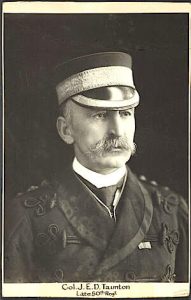
J E D Taunton was born in England at Gloucester, enlisted in the British Army, fought in the Maori Wars, and served with his regiment until 1875 when he resigned his commission. He then settled in Sydney where he joined the NSW Permanent Forces. In 1900 he appeared before a Legislative Assembly inquiry into Boer War troops being issued the wrong helmets and badly made carts. On his retirement he returned to England where he died in 1938, predeceased by his wife and survived by four sons and five daughters.
Carl and Catherine Carlson
By 1902 William Robert Pope’s financial affairs were in a mess. Trade had fallen off and he lost money playing poker and betting on horses. He was unable to pay back the £150 he had borrowed from his brother-in-law and another £150 his mother had given him to be shared among his three boys he sank into his business. Examined for bankruptcy, he sold the Glebe house for £2,125 and embarked on a new career as a bookmaker. His wife, Jessie Maria, born White, divorced him in 1916. A ‘turf commission agent’ of Cremorne Point and City Tattersall’s Club, Pope died on 22 December 1930.
Wahroonga’s buyer was Carl Carlson, a native of Pataholm in Sweden. The stevedore changed his new home’s name to Carlson House. Carlson had arrived in Sydney by 1865 when he married Catherine Gallagher, a native of Donegal in Ireland. Annie Sophine, their only child, was born the following year. The family were practising Catholics and worshipped locally at St James Church. Carl Carlson died aged 67 at home on 1 August 1904 and was interred in the Catholic section of Rookwood Cemetery. Executors of his £40,505 estate were his widow and daughter, now a married woman.
Catherine Carlson died at home on 5 February 1916 and was buried near her husband. Catherine’s unmarried sister Annie Gallagher also lived at Glebe Point. She died at age 76 in the Sacred Heart Hospice and was buried in the Carlson family grave.
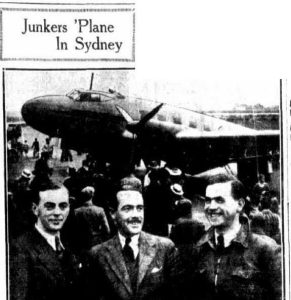
Annie Sophine and John Alexander Kerr
Annie Sophine Carlson married John Alexander Kerr, an insurance manager, in 1899. They were parents of Carl Otto Vilbad Carlson (1901-61), Annie Sophie known as Nancy (1902–1984), Jennie Alexandria Catherine known as Jean (1906 -38) and John Alexander Carlson known as Jack (1907–1975). After her father’s death Annie Kerr shared the Glebe house (now often referred to by its former name Wahroonga) with her mother and her own growing family.
Annie Kerr took charge of domestic affairs and, at a time when household help was hard to find, promised liberal outings for potential housemaids, parlour maids, cooks and general servants. Wahroonga was an ideal venue for social events, with large rooms for taking supper and the billiard room for dancing. Nancy’s 18th and Carl’s 21st birthdays were celebrated there. Heating was provided by ceramic stoves imported from the Austro-Hungarian Empire.
John Kerr senior was keen on motoring and was a member of the Sydney Liedertafel. After retiring from business in 1914, he became active in the NSW Figure Skating Association. Three of his children took up ice skating as a sport.
Trained as an electrician, Carl Kerr played and refereed ice hockey. He won the Goodall Cup in 1921, was a Life member of the NSW Ice Hockey Association and on the committee of the Glaciarium Ice Hockey Club. In 1926 he married Mabel Boyce of Centennial Park, also a champion skater.
Nancy was a member of the women’s ice hockey team which won the Gower Cup in 1922. She was second place-getter in the 1924 speed skating championship, NSW Ladies Figure Skating Champion in 1925 and a 1926 medallist. In 1927 in Melbourne she married William Michael Dixon whose medical studies had been interrupted by service in the First World War. He became a salesman and manager. In retirement the couple moved to Surfers Paradise where William died in 1967 and his widow in 1984.
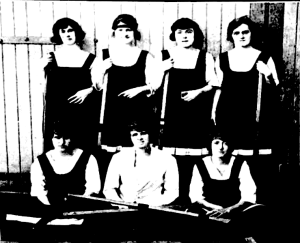
The marriage of the Kerrs’ second daughter Jean to Arthur Hatherleigh Weston was celebrated in style in 1923, with a ceremony at St Mary’s Cathedral followed by a reception at the Hotel Australia. But the union was not a happy one and Jean walked out. In 1927 she was issued with a court order to go back to her husband who sued for divorce the next year. Survived by her ex and three daughters, Jean Weston died aged 31 in 1938 and was buried in the Carlson family grave at Rookwood.
Jack Kerr was in the winning Goodall Cup ice hockey team in 1925, 1926 and 1929 and played tennis and golf. He made aviation his career. After employment as chief instructor with the NSW Aero Club, he was a senior captain with Airlines of Australia (AOA) and senior flying inspector in the Civil Aviation Branch, Dept of Defence. In 1932 he was in a two-seater plane with Charles Ulm which crashed into power lines in Victoria. The men survived because of the quick action of a female bystander who beat out the flames. In 1937 he took part in the aerial search for the AOA’s City of Brisbane which crashed at Lamington Plateau, killing the crew and four passengers. Jack Kerr, who married Dorothy Edna Lindbergh in 1941, died on 18 May 1975.
Annie Sophine Kerr died on 19 June 1934, leaving considerable real estate. Her widower died aged 70 on 13 October 1936. Both were interred in the Carlson plot at Rookwood. Their address at death was The Tor, a block of flats in Barncleuth Square, Elizabeth Bay.
The Kerrs had left Glebe years before. In February 1924 they advertised Wahroonga for auction as suitable for conversion to a private hospital or flats; later that year it was bought by the NSW government. Renamed Royleston, it became a Child Welfare Department Home for Wayward and Abandoned Boys and there were annual appeals from the superintendent for volunteers to take his charges (some as young as seven years) into their homes for Christmas. In 1983 the building became a children’s court. That function was transferred to Bidura in 1992 and the following year the property reverted to private ownership. The buyer was Liz Trickett who sold off the rear block and used the money to transform the mansion into Trickett’s bed and breakfast. After she retired, the property was sold in 2016.

Sources: The Australian Encyclopaedia; icelegendsaustralia.com; National Archives of Australia; NSW cemetery records; NSW electoral rolls; NSW registry of births, deaths and marriages; Sands Directories; Trove website.
Note: An article by Margaret Sheppard on Tricketts appeared in Bulletin 7/ 2006. Rodney Hammett wrote about schoolmaster John Pendrill in Bulletin 7/2019. The Bulletin 6/2008 article on Montana 36 Boyce Street included information on George McCredie.









There are no comments yet. Please leave yours.